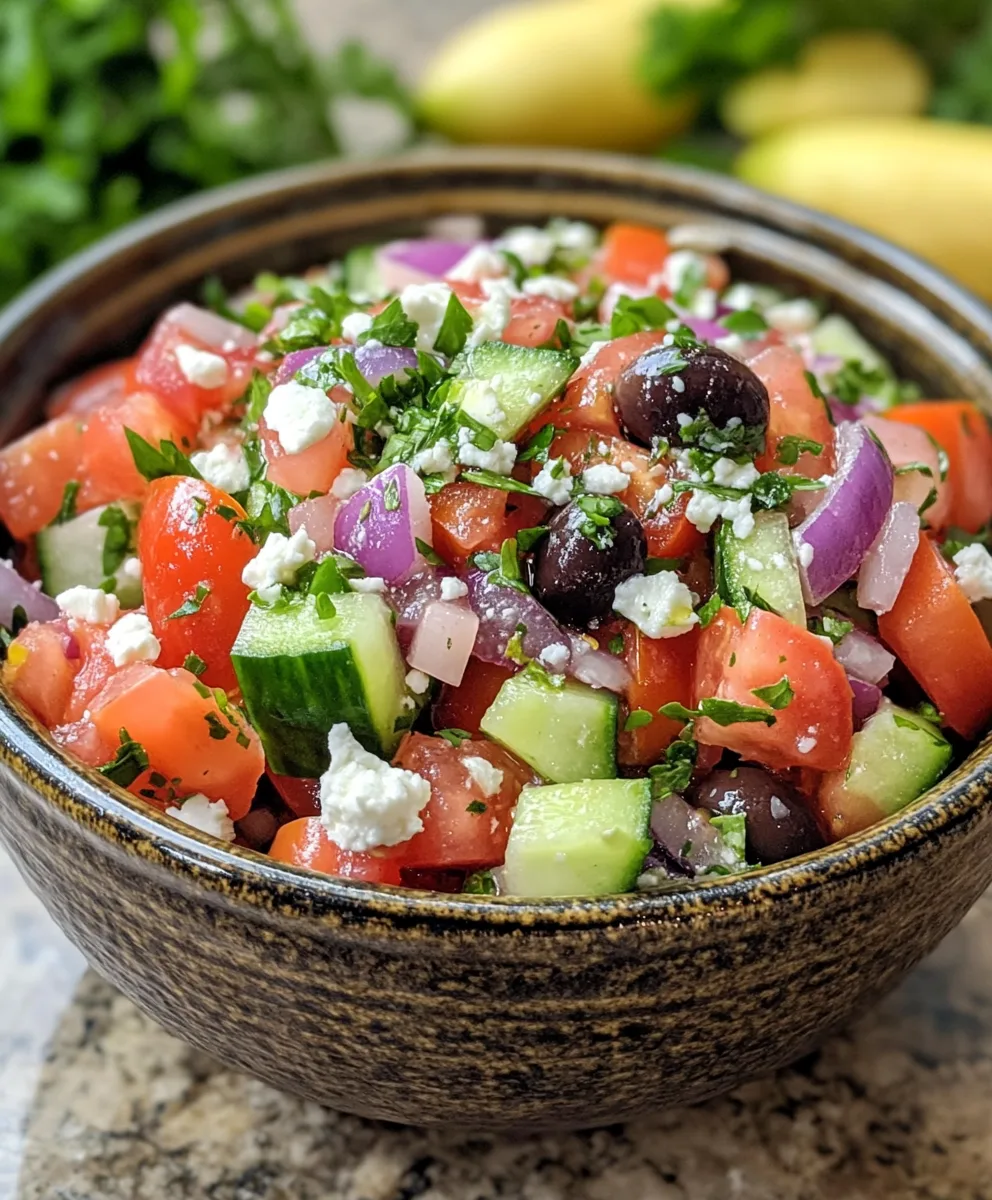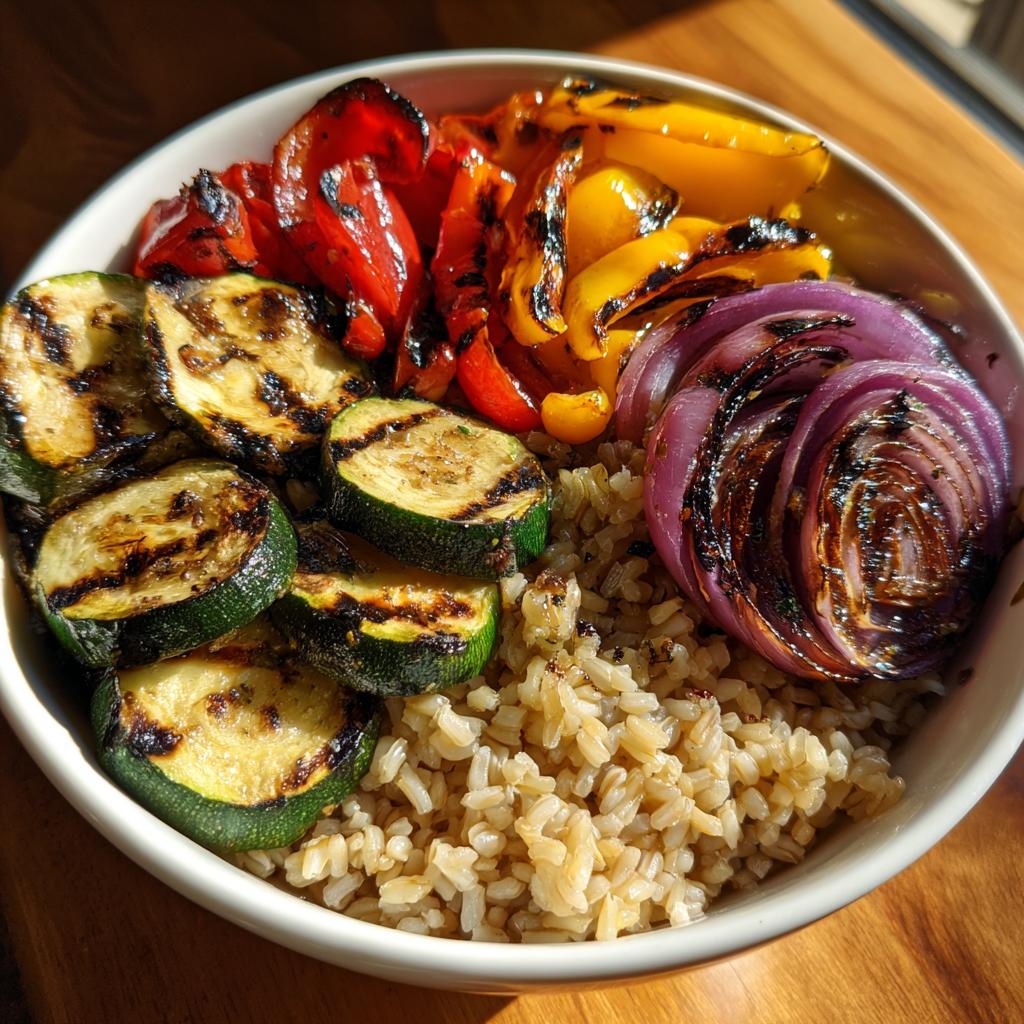Greek salsa is a delightful and vibrant dish that brings the flavors of the Mediterranean right to your table. This refreshing mix of fresh vegetables, olives, and feta cheese creates a burst of taste that is both healthy and satisfying. Whether you’re hosting a gathering or simply enjoying a quiet evening at home, Greek salsa is the perfect addition to any meal.
Ingredients for Greek Salsa
Fresh Ingredients for Authentic Flavor
To create a truly authentic Greek salsa, using fresh ingredients is key. Each component contributes to the overall taste and texture of the dish. Here’s a closer look at the essential ingredients:
- Tomatoes: Use ripe, medium tomatoes for a juicy base. Their sweetness balances the other flavors.
- Red Onion: A small red onion adds a sharp, tangy bite. Finely chopping it ensures even distribution in the salsa.
- Cucumber: Half a cucumber provides a refreshing crunch. Dicing it into small pieces helps it blend well with the other ingredients.
- Kalamata Olives: These pitted olives bring a rich, briny flavor. Chopping them enhances their presence in the salsa.
- Feta Cheese: Crumbled feta adds creaminess and a salty kick. It’s important to fold it in gently to maintain its texture.
- Fresh Parsley: Chopped parsley not only adds color but also a fresh herbal note that brightens the dish.
- Olive Oil: A drizzle of high-quality olive oil enriches the salsa, making it smooth and flavorful.
- Lemon Juice: Fresh lemon juice adds acidity, balancing the richness of the feta and olives.
- Dried Oregano: This herb is a classic in Greek cuisine, providing an earthy flavor that ties everything together.
- Salt and Pepper: These basic seasonings enhance the overall taste, allowing the fresh ingredients to shine.
Optional Ingredients to Enhance Greek Salsa
While the basic recipe is delicious on its own, you can elevate your Greek salsa with a few optional ingredients. Here are some ideas:
- Garlic: A minced garlic clove adds a robust flavor. Just a little can make a big difference!
- Red Pepper Flakes: For those who enjoy a bit of heat, a pinch of red pepper flakes can spice things up.
- Bell Peppers: Diced bell peppers add sweetness and crunch. Choose red, yellow, or green for a colorful twist.
- Capers: These briny little buds can enhance the Mediterranean flavor profile even further.
- Avocado: Adding diced avocado introduces creaminess and a different texture, making the salsa even more satisfying.
Feel free to mix and match these optional ingredients to create your perfect version of Greek salsa. The beauty of this dish lies in its versatility!
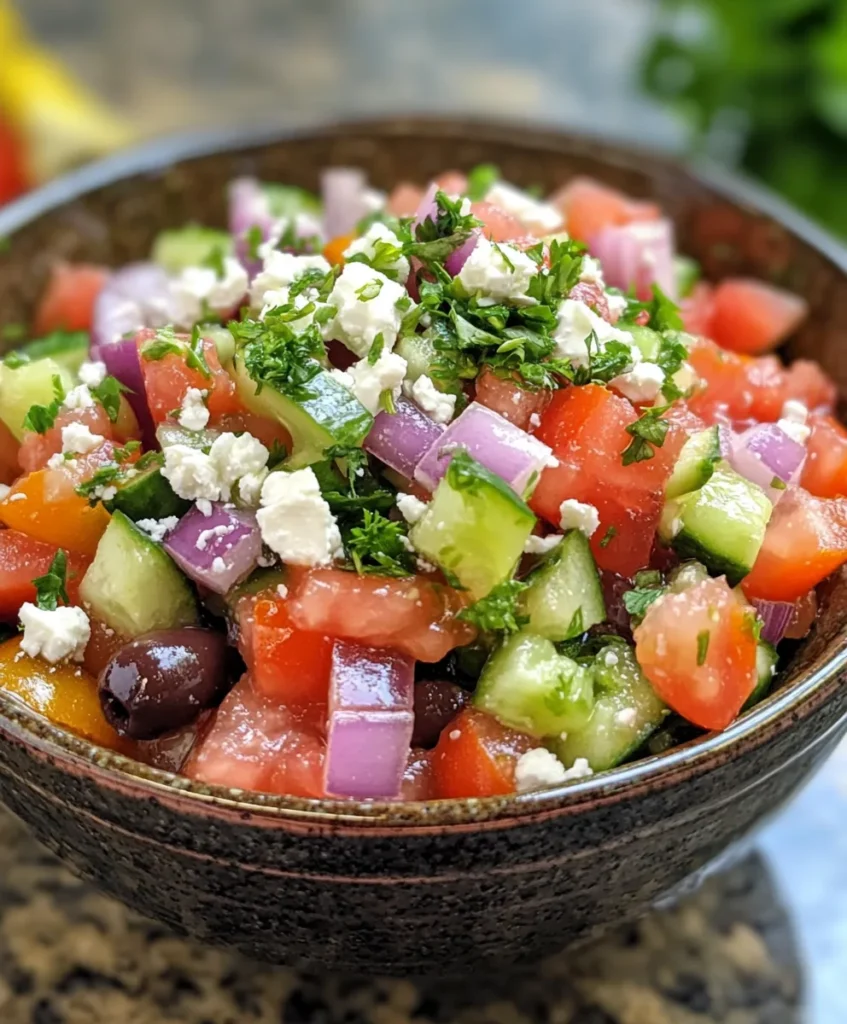
Tools Needed for Making Greek Salsa
Essential Kitchen Tools
Creating a delicious Greek salsa requires just a few essential kitchen tools. Having the right equipment makes the preparation process smooth and enjoyable. Here’s what you’ll need:
- Cutting Board: A sturdy cutting board provides a safe surface for chopping vegetables and herbs.
- Sharp Knife: A sharp knife is crucial for dicing tomatoes, cucumbers, and onions with ease.
- Mixing Bowl: A large mixing bowl is necessary for combining all the fresh ingredients. It allows enough space to mix without spilling.
- Spatula or Spoon: Use a spatula or a spoon to gently fold in the feta cheese and mix the salsa without mashing the ingredients.
- Measuring Spoons: Accurate measurements of olive oil, lemon juice, and seasonings ensure the perfect balance of flavors.
- Plastic Wrap: Covering the bowl with plastic wrap helps the salsa chill and allows the flavors to meld together.
Recommended Serving Utensils
Once your Greek salsa is ready, serving it beautifully enhances the dining experience. Here are some recommended serving utensils:
- Rustic Serving Bowl: A rustic bowl adds charm and showcases the vibrant colors of the salsa.
- Serving Spoon: A large serving spoon makes it easy for guests to help themselves to the salsa.
- Pita Chips or Bread Basket: Presenting pita chips or fresh bread in a basket encourages dipping and sharing.
- Small Plates: Individual small plates allow guests to enjoy the salsa alongside their main dishes.
With these tools in hand, you’re all set to prepare and serve your delightful Greek salsa. Enjoy the process and the delicious results!
Step-by-Step Preparation of Greek Salsa
Step 1: Prepare the Vegetables
To kick off your Greek salsa, start by preparing the vegetables. First, wash the tomatoes, cucumber, and parsley thoroughly. This step ensures that your salsa is clean and fresh. Next, dice the tomatoes and cucumber into small, uniform pieces. This helps them blend well together. Then, finely chop the red onion and set it aside. The onion adds a nice crunch and flavor to the salsa.
Step 2: Combine the Ingredients
Once your vegetables are ready, it’s time to combine them. In a large mixing bowl, add the diced tomatoes, chopped red onion, diced cucumber, and chopped Kalamata olives. These ingredients form the base of your Greek salsa. Make sure to mix them gently to avoid bruising the tomatoes. This step is crucial for maintaining the salsa’s texture.
Step 3: Add the Feta
Now, it’s time to add the star ingredient: feta cheese! Gently fold in the crumbled feta cheese into the mixture. Be careful not to break it up too much. You want to keep some larger pieces for that creamy texture. The feta adds a salty and tangy flavor that perfectly complements the fresh vegetables.
Step 4: Season the Salsa
Next, it’s time to season your salsa. Drizzle the olive oil and lemon juice over the mixture. These ingredients add richness and acidity, enhancing the overall flavor. Then, sprinkle in the dried oregano, along with salt and pepper to taste. Seasoning is essential, as it brings all the flavors together. Don’t be shy; taste as you go!
Step 5: Mix Gently
Using a spatula or spoon, gently mix all the ingredients until they are well combined. Be careful not to mash the tomatoes or feta. You want to keep the salsa looking fresh and vibrant. A gentle touch ensures that each ingredient retains its shape and flavor.
Step 6: Garnish
After mixing, it’s time to add a touch of color. Add the chopped fresh parsley on top of the salsa. This not only enhances the visual appeal but also adds a fresh herbal note. Give it one last gentle stir to incorporate the parsley without disturbing the other ingredients too much.
Step 7: Chill
For the best flavor, cover the bowl with plastic wrap and let the salsa chill in the refrigerator. Allow it to sit for at least 30 minutes. This chilling time allows the flavors to meld together beautifully. The longer it sits, the more delicious it becomes!
Step 8: Serve
Finally, it’s time to serve your Greek salsa! Transfer it to a rustic bowl for a beautiful presentation. This salsa is perfect as a refreshing dip with pita chips or as a topping for grilled meats or fish. Enjoy the vibrant, Mediterranean flavors that will surely impress your guests!
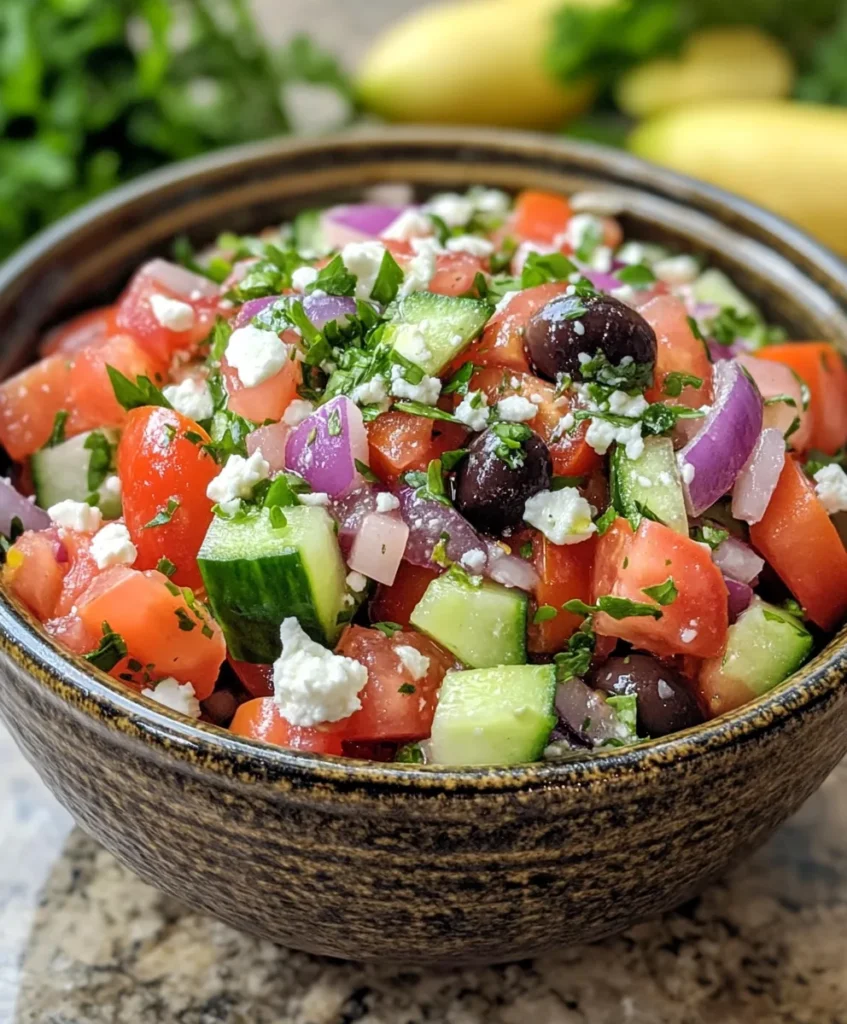
Serving Suggestions for Greek Salsa
Best Pairings with Greek Salsa
Greek salsa is incredibly versatile and pairs well with a variety of dishes. Here are some of the best pairings to enhance your dining experience:
- Pita Chips: The classic choice! Crunchy pita chips are perfect for scooping up the salsa, making for a delightful appetizer.
- Grilled Chicken: Serve Greek salsa on top of grilled chicken for a refreshing twist. The flavors complement each other beautifully.
- Fish Tacos: Add a spoonful of Greek salsa to fish tacos for a zesty kick. It adds freshness and a Mediterranean flair.
- Stuffed Peppers: Use Greek salsa as a topping for stuffed peppers. It adds color and flavor to this hearty dish.
- Salads: Mix Greek salsa into your salads for an extra burst of flavor. It works well with greens, grains, or even pasta salads.
Creative Ways to Use Greek Salsa
Beyond traditional serving methods, there are many creative ways to enjoy Greek salsa. Here are some fun ideas:
- Bruschetta: Spread Greek salsa on toasted bread slices for a quick and tasty appetizer. Top with a drizzle of balsamic glaze for added flavor.
- Omelets: Incorporate Greek salsa into your morning omelet. It adds a fresh and tangy element to your breakfast.
- Wraps: Use Greek salsa as a filling in wraps or sandwiches. It pairs well with turkey, hummus, or grilled vegetables.
- Quinoa Bowls: Top a quinoa bowl with Greek salsa for a nutritious and colorful meal. It adds texture and flavor to the dish.
- Marinade: Use Greek salsa as a marinade for meats. The acidity from the lemon juice helps tenderize the meat while infusing it with flavor.
With these serving suggestions, you can enjoy Greek salsa in many delightful ways. Its fresh and vibrant flavors will surely elevate any meal!
Tips for Making the Perfect Greek Salsa
Flavor Enhancements for Greek Salsa
To take your Greek salsa to the next level, consider these flavor enhancements. Each tip adds a unique twist to the classic recipe:
- Fresh Herbs: Besides parsley, try adding fresh mint or dill. These herbs bring a refreshing taste that complements the other ingredients.
- Spices: Experiment with spices like cumin or smoked paprika. A pinch can add depth and warmth to your salsa.
- Vinegar: A splash of red wine vinegar can enhance the acidity. It brightens the flavors and adds a tangy kick.
- Honey: For a touch of sweetness, drizzle a little honey into the mix. This balances the acidity and adds complexity.
- Roasted Vegetables: Consider roasting some of the vegetables, like bell peppers or tomatoes. Roasting brings out their natural sweetness and adds a smoky flavor.
Feel free to mix and match these enhancements to create a Greek salsa that suits your taste. The beauty of this dish lies in its adaptability!
Storage Tips for Greek Salsa
To keep your Greek salsa fresh and delicious, follow these storage tips:
- Refrigeration: Store your Greek salsa in an airtight container in the refrigerator. This helps maintain its freshness and flavor.
- Consume Quickly: For the best taste, enjoy your salsa within two days. The flavors are at their peak when fresh.
- Separation: If you notice any liquid separation, simply give the salsa a gentle stir before serving. This is normal and doesn’t affect the taste.
- Freezing: While not ideal, you can freeze Greek salsa for up to a month. However, the texture may change upon thawing, so it’s best enjoyed fresh.
- Keep Ingredients Separate: If you plan to make it ahead of time, consider storing the feta cheese separately. This prevents it from becoming too soggy.
By following these storage tips, you can enjoy your Greek salsa for longer while keeping its vibrant flavors intact!
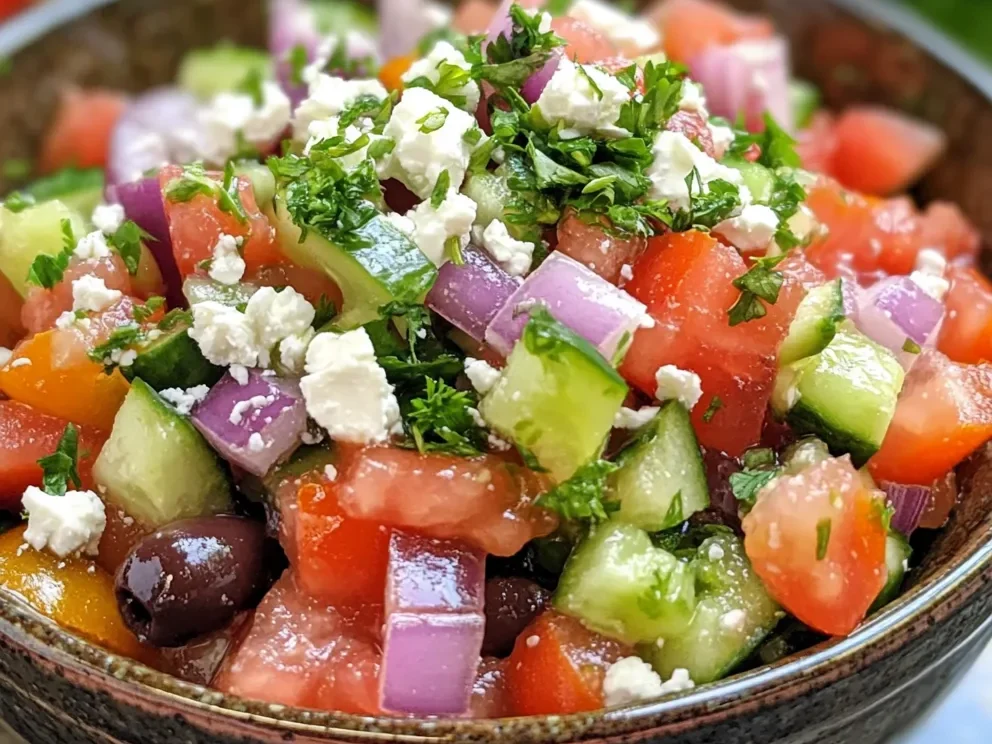
FAQs About Greek Salsa
Can I make Greek Salsa ahead of time?
Absolutely! Greek salsa can be made ahead of time, which is great for meal prep or entertaining. In fact, letting it chill in the refrigerator for a few hours or overnight allows the flavors to meld beautifully. Just remember to give it a gentle stir before serving to mix everything back together. This way, you can enjoy a delicious and flavorful salsa without the last-minute rush!
What can I substitute for feta cheese in Greek Salsa?
If you’re looking for a substitute for feta cheese, there are several options. For a similar texture, you can use goat cheese or ricotta. Both provide creaminess and a tangy flavor. If you’re avoiding dairy, try using crumbled tofu mixed with a bit of lemon juice and salt for a vegan alternative. Nutritional yeast can also add a cheesy flavor without the dairy!
Is Greek Salsa suitable for a vegan diet?
Traditional Greek salsa contains feta cheese, which is not vegan. However, you can easily make it vegan by omitting the feta or substituting it with crumbled tofu or a dairy-free cheese alternative. The rest of the ingredients, like tomatoes, cucumbers, and olives, are naturally vegan, making this dish a great option for plant-based diets!
How long does Greek Salsa last in the refrigerator?
Greek salsa is best enjoyed fresh, but it can last in the refrigerator for up to two days. After that, the vegetables may start to lose their crispness, and the flavors can become muted. To keep it fresh, store it in an airtight container. If you notice any liquid separation, just give it a gentle stir before serving. Enjoy your salsa while it’s still vibrant and tasty!
Conclusion: Enjoying Your Greek Salsa Experience
In conclusion, Greek salsa is more than just a dish; it’s a celebration of fresh ingredients and vibrant flavors. This delightful mix of tomatoes, cucumbers, olives, and feta cheese brings the essence of the Mediterranean right to your table. Whether you’re enjoying it as a dip, a topping, or a side, Greek salsa adds a refreshing touch to any meal.
Print
Greek Salsa is a delicious twist on traditional salsa.
- Total Time: 45 minutes (including chilling time)
- Yield: 4 servings 1x
- Diet: Vegetarian
Description
Greek salsa is a delightful and vibrant dish that brings the flavors of the Mediterranean right to your table. This refreshing mix of fresh vegetables, olives, and feta cheese creates a burst of taste that is both healthy and satisfying.
Ingredients
- 2 medium ripe tomatoes
- 1 small red onion
- 1/2 cucumber
- 1/2 cup Kalamata olives
- 1/2 cup crumbled feta cheese
- 1/4 cup chopped fresh parsley
- 2 tablespoons olive oil
- 2 tablespoons fresh lemon juice
- 1 teaspoon dried oregano
- Salt and pepper to taste
Instructions
- Prepare the vegetables by washing and dicing the tomatoes, cucumber, and red onion.
- Combine the diced tomatoes, chopped red onion, diced cucumber, and chopped Kalamata olives in a large mixing bowl.
- Gently fold in the crumbled feta cheese.
- Drizzle olive oil and lemon juice over the mixture, then sprinkle in dried oregano, salt, and pepper.
- Mix gently to combine all ingredients without mashing them.
- Garnish with chopped fresh parsley.
- Cover with plastic wrap and chill in the refrigerator for at least 30 minutes.
- Serve in a rustic bowl with pita chips or as a topping for grilled meats or fish.
Notes
- Feel free to add optional ingredients like garlic, red pepper flakes, or diced bell peppers for extra flavor.
- Store leftovers in an airtight container in the refrigerator for up to two days.
- For a vegan version, substitute feta cheese with crumbled tofu or a dairy-free cheese alternative.
- Prep Time: 15 minutes
- Cook Time: 0 minutes
- Category: Appetizer
- Method: Mixing
- Cuisine: Mediterranean
Nutrition
- Serving Size: 1/4 cup
- Calories: 120
- Sugar: 3g
- Sodium: 250mg
- Fat: 9g
- Saturated Fat: 3g
- Unsaturated Fat: 6g
- Trans Fat: 0g
- Carbohydrates: 8g
- Fiber: 2g
- Protein: 4g
- Cholesterol: 10mg
Keywords: Greek salsa, Mediterranean dip, fresh salsa, healthy appetizer


